Audio Archive
During the exhibition series 1946, 1947, 1948, diverse aspects of bookmaking were discussed in ten events with various guest speakers. Excerpts of the recordings are collected here; the website complements the publication appearing in spring 2013 with Niggli Verlag.
In 1943, Jan Tschichold suggested a book competition that would recognise annually the most beautiful Swiss books – yet already in the years 1946, 1947 and 1948, the competition was interrupted and books were neither judged nor recognised. These three forgotten years were the inspiration behind, on the one hand, thematising in an exhibition the different aspects of book design in the 1940s, and on the other hand, discussing contemporary book design and production in ten presentations.
-
Any left? On Ideologies and Graphic Design
21.11.2010
In 1946 Max Bill and Jan Tschichold, in a written confrontation, argued bitterly about symmetry and asymmetry in book design. This incident is not a rarity for the 1940s era, in which positions on design were sometimes
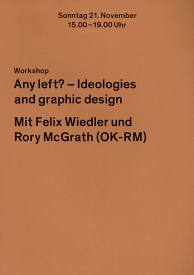 clearly oppositional and different styles were defined dogmatically and the symmetry question took on a political dimension. Were these positions, however, really so clear? Beyond the extremes, what was the graphic designer’s daily bread? And what are the positions today? Are we left with only trends? The workshop is led by book collector Felix Wiedler of Winterthur and graphic designer Rory McGrath of London.
clearly oppositional and different styles were defined dogmatically and the symmetry question took on a political dimension. Were these positions, however, really so clear? Beyond the extremes, what was the graphic designer’s daily bread? And what are the positions today? Are we left with only trends? The workshop is led by book collector Felix Wiedler of Winterthur and graphic designer Rory McGrath of London. -
The Swiss and Their Books, Post-1945
23.11.2010
Film historian and native of Zurich Severin Rüegg presents Die Gezeichneten (dir. Fred Zinnemann), a film which, only a short time after the second world war, shed light on the crimes in Europe. For a long
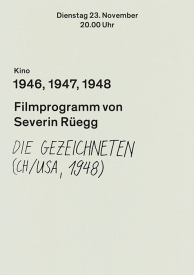 time, the film remained unique. Swiss domestic politics embraced a mood of departure from the past, and, while it led to the acceptance of the AHV and thus to an important social-political course, foreign policy was concerned with encouraging a quick forgetting of the recent past. How do we evaluate this period today? What has been handed down and with which images are we familiar; which are we willing to forget? The evening mediates an insight into the historical context of the exhibition.
time, the film remained unique. Swiss domestic politics embraced a mood of departure from the past, and, while it led to the acceptance of the AHV and thus to an important social-political course, foreign policy was concerned with encouraging a quick forgetting of the recent past. How do we evaluate this period today? What has been handed down and with which images are we familiar; which are we willing to forget? The evening mediates an insight into the historical context of the exhibition. -
Double page with a disco ball, bleed-off. How the photo book is celebrating its renaissance today
01.12.2010
Yet another event devoted to the photo book? Together with photographers Linus Bill, Mirjam Fischer of Edition Patrick Frey and the art- and photography historian Ulrike Meyer Stump, we would like to approach the theme
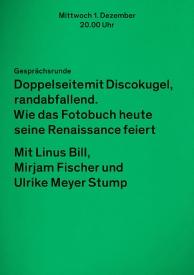 of the photo book from various perspectives.
of the photo book from various perspectives.Photography takes on another meaning in the form of the book. In the 1940s, several Swiss photography pioneers dedicated themselves to the book, some of which are present in the exhibition. How do contemporary publishers, photographers, and authors treat the genre of the photo book? When is it simply a portfolio, and when does the book give the photographer’s work additional meaning?
-
Dove riposano i libri? A proposito degli archivi di Monte Verita, Jan Tschichold, Harald Szeemann e Armand Schulthess
08.05.2011
As curators, Patrick Gosatti and Noah Stolz have confronted the thematic of the contemporary archive in several exhibitions. Taking up this topic for the exhibition at the La Rada gallery, a discussion round with various
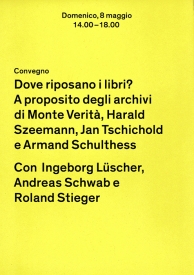 personalities was organised in which they addressed different archives in the canton of Ticino. Roland Stieger describes the refurbishment of Jan Tschichold’s library in Berzona and Andreas Schwab speaks about his work over many years with the Monte Verita archive. Ingeborg Lüscher discusses her fascination and work with the collected works of Armand Schulthess.
personalities was organised in which they addressed different archives in the canton of Ticino. Roland Stieger describes the refurbishment of Jan Tschichold’s library in Berzona and Andreas Schwab speaks about his work over many years with the Monte Verita archive. Ingeborg Lüscher discusses her fascination and work with the collected works of Armand Schulthess. -
Le plus beau livre romand?
04.06.2011
Is there such a thing as a typical livre romand? And if yes, how would it be described – are the characteristics formal or structural? The discussion round explores the topic of the livre romand, a category that
 appeared to be clearly recognisable in the 1940s, yet which seems to be lost today. Nevertheless, it is appropriate to thematise book design and production in Romany, especially because it describes the influence of the language region, also with regard to the behaviour of the client, which could clearly have an effect on the valuation of book design.
appeared to be clearly recognisable in the 1940s, yet which seems to be lost today. Nevertheless, it is appropriate to thematise book design and production in Romany, especially because it describes the influence of the language region, also with regard to the behaviour of the client, which could clearly have an effect on the valuation of book design. -
Making Books. A Short History of Production Conditions and Their Consequences
22.11.2010
The film night illustrates the technical developments in bookbinding and the printing industry using two films as documents. Albert Burkhardt, in 1941, founded his bookbindery at Kreuzplatz in Zurich and, as a passionate
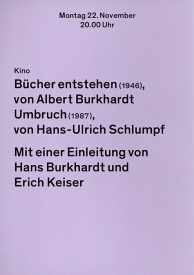 amateur filmmaker, documented his workshop with short educational films. Hans Burkhardt heads the second-generation bookbindery BUBU and introduces a short film by his father. The second film is the documentary Umbruch by Hans-Ulrich Schlumpf. Erich Keiser of the printer Odermatt in Dallenwil speaks from his own experience about the departure of monotype and machine-type and comments on the rise of desktop publishing shown in the film. (The movie by Albert Burkhardt can be found here)
amateur filmmaker, documented his workshop with short educational films. Hans Burkhardt heads the second-generation bookbindery BUBU and introduces a short film by his father. The second film is the documentary Umbruch by Hans-Ulrich Schlumpf. Erich Keiser of the printer Odermatt in Dallenwil speaks from his own experience about the departure of monotype and machine-type and comments on the rise of desktop publishing shown in the film. (The movie by Albert Burkhardt can be found here) -
Who reads that, anyway? On the typography of reading, somewhere between New Wave and Text-Heaviness
27.11.2010
How experimental can a text layout be and what would we still consider readable? And, conversely, how simple can a layout be before it bores us, before we no longer want to read the text? The books from the exhibition
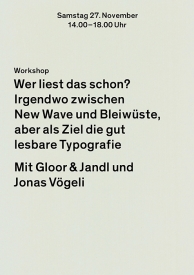 served in the workshop as search material to discover what we consider readable today, and as basis for a discussion on whether directed reading, readability, and acceptability among readers can still be considered today as important criteria? A workshop led by Jonas Vögeli and Hannes Gloor, both graphic designers in Zurich.
served in the workshop as search material to discover what we consider readable today, and as basis for a discussion on whether directed reading, readability, and acceptability among readers can still be considered today as important criteria? A workshop led by Jonas Vögeli and Hannes Gloor, both graphic designers in Zurich. -
Natural Selection. On Current Collection and Library Strategies
29.11.2010
The Most Beautiful Swiss Books, the title of the competition, describes a very subjective choice. Who decides what is beautiful? Can this be seen through criteria that objectifies the decision? Graphic designer Linda
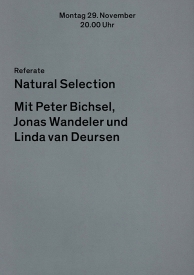 van Deursen is a jury member of the competition and speaks about the activities of the jury and her view of how books per se can be perceived. Book antiquarian Peter Bichsel sees himself confronted daily with selecting books. How he proceeds in this and which categories are helpful are the focus of his presentation. What happens at the library and what influences our behaviour at the bookshelf are the subjects addressed in the publication Period of traces by graphic designer Jonas Wandeler. He summarises his project and presents it in the context of the exhibition.
van Deursen is a jury member of the competition and speaks about the activities of the jury and her view of how books per se can be perceived. Book antiquarian Peter Bichsel sees himself confronted daily with selecting books. How he proceeds in this and which categories are helpful are the focus of his presentation. What happens at the library and what influences our behaviour at the bookshelf are the subjects addressed in the publication Period of traces by graphic designer Jonas Wandeler. He summarises his project and presents it in the context of the exhibition.
